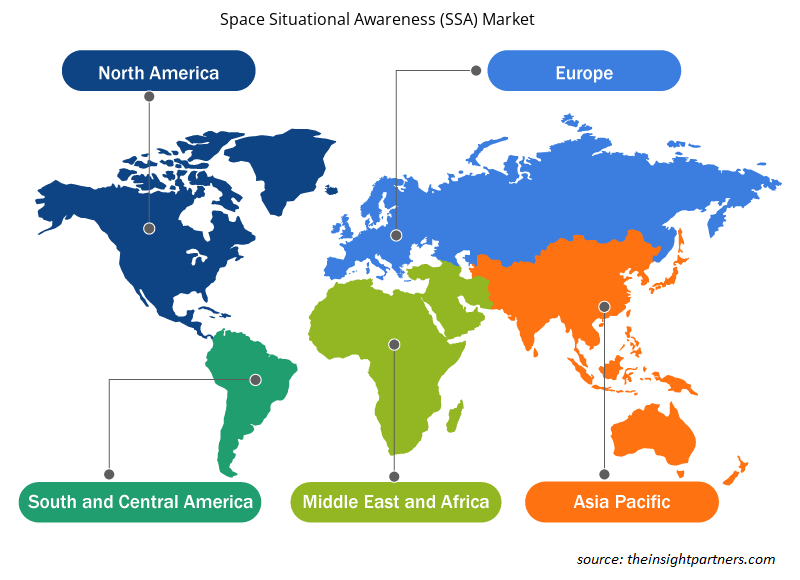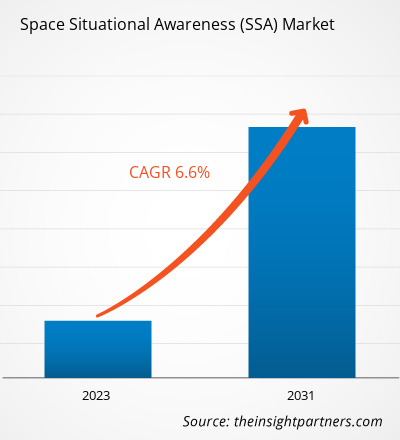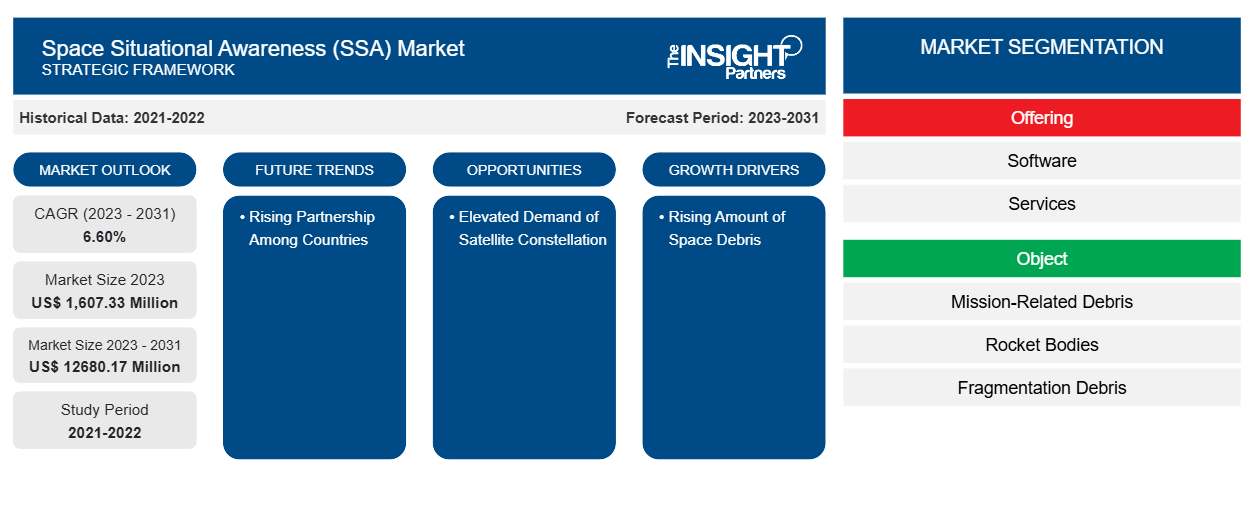Le marché de la connaissance de la situation spatiale (SSA) devrait atteindre 12 680,17 millions USD d'ici 2031, contre 1 607,33 millions USD en 2023. Le marché devrait croître à un TCAC de 6,60 % d'ici 2031. La croissance du marché de la connaissance de la situation spatiale est tirée par les pays dotés d'organisations d'exploration spatiale de premier plan, par l'augmentation des investissements dans la recherche spatiale et par de nouveaux types d'opérations spatiales générant de nouvelles menaces pour le maintien d'informations précises sur les orbites des objets spatiaux. Les États-Unis, la Russie, la Chine, le Royaume-Uni, le Japon et la France sont quelques-uns des principaux pays exploitant le plus grand nombre de satellites dans l'espace.
Analyse du marché de la connaissance de la situation spatiale (SSA)
Français Un certain nombre d'objets tels que des sondes, des satellites, des engins spatiaux habités, des atterrisseurs et des éléments de vol de stations spatiales sont lancés en orbite terrestre et au-delà pour des missions d'exploration interplanétaire afin de mieux comprendre le cosmos. Selon le Bureau des affaires spatiales des Nations Unies (UNOOSA), 2 163 objets ont été lancés dans l'espace en 2022, tandis qu'en 2021 et 2020, un total de 1 810 et 1 274 objets, respectivement, ont été lancés. Le nombre de lancements de fusées spatiales, principalement pour déployer des satellites dans l'espace, augmente également rapidement. En 2021, il y a eu 136 lancements de fusées réussis, alors qu'en 2022, ce nombre est passé à 180. Au cours du premier semestre 2022, des entreprises basées aux États-Unis ont lancé 37 fusées, dont 27 par SpaceX, 4 par RocketLab, 3 par United Launch Alliance et 1 par Astra, Northrop Grumman et Virgin Orbit. La Chine, la Russie et l'Inde ont lancé respectivement 21, 9 et 2 fusées au cours du premier semestre 2022. Sur les 21 lancements de fusées effectués par la Chine, la fusée Kuaizhou 1A a déployé un petit satellite de recherche nommé Tianxing 1 sur une orbite polaire à basse altitude à moins de 290 km au-dessus de la Terre. De nouveau, en janvier 2023, la Chine a lancé 14 satellites au sommet d'une fusée porteuse Longue Marche-2D depuis le centre de lancement de satellites de Taiyuan, dans la province du Shanxi, au nord de la Chine. Les 14 satellites comprenaient Qilu-2 et Qilu-3, Luojia-3 01 et Jilin-1 Gaofen 03D34. En février 2023, l'Organisation indienne de recherche spatiale (ISRO) a annoncé le déploiement réussi de trois satellites sur leurs orbites prévues via le véhicule SSLV-D2.
Aperçu du marché de la connaissance de la situation spatiale (SSA)
La connaissance de la situation spatiale (SSA) est un élément essentiel de la connaissance du domaine spatial (SDA) qui aide les décideurs à comprendre les environnements opérationnels actuels et prévus. La SSA suit et identifie les objets qui aident à déterminer leurs orbites, à comprendre leur environnement fonctionnel et à prévoir les positions et les défis futurs de leurs opérations. En outre, la SSA aide à estimer les débris provenant des tempêtes de météores, des événements de fragmentation ou d'autres événements naturels potentiels qui peuvent affecter les opérations spatiales. La SSA est une base pour toutes les activités de gestion du trafic spatial (STM) et de sécurité spatiale. Par conséquent, tous ces avantages de la SSA propulsent sa pénétration.
Personnalisez ce rapport en fonction de vos besoins
Vous bénéficierez d'une personnalisation gratuite de n'importe quel rapport, y compris de certaines parties de ce rapport, d'une analyse au niveau des pays, d'un pack de données Excel, ainsi que de superbes offres et réductions pour les start-ups et les universités.
-
Obtenez les principales tendances clés du marché de ce rapport.Cet échantillon GRATUIT comprendra une analyse de données, allant des tendances du marché aux estimations et prévisions.
Facteurs moteurs et opportunités du marché de la connaissance de la situation spatiale (SSA)
Augmentation du nombre de débris spatiaux
En 2021, Space Track a signalé quatre événements de désintégration en orbite générant 150 débris de fragments et deux événements de collision produisant 942 objets, dont celui du test ASAT russe. Ces débris spatiaux en orbite menacent environ 3 000 satellites opérationnels actuellement en orbite, utilisés pour les communications critiques modernes et à d'autres fins. Tout dommage, même mineur, à ces actifs spatiaux peut avoir des répercussions en cascade sur de nombreux systèmes vitaux, notamment les communications , le transport, la planification du temps et les aspects critiques liés à la défense. De nombreuses technologies de défense de pointe telles que les missiles guidés, les drones, la collecte de données de renseignement, les communications cryptées et la navigation seraient limitées ou pourraient devenir inopérantes avec des systèmes de satellites obsolètes. Il est donc crucial d'analyser l'approche comparative de tous les objets spatiaux pour détecter les menaces de collision bien à l'avance. La SSA s'occupe de la connaissance approfondie de l'environnement spatial, de l'évaluation de toute menace pour les activités spatiales et de la mise en œuvre des mesures d'atténuation nécessaires pour protéger les actifs spatiaux fonctionnels. Elle joue donc un rôle crucial pour garantir des activités spatiales sûres et durables conformes aux directives, normes et autres normes nationales et internationales. En raison de la fonctionnalité critique des SSA et de l’importance croissante des satellites, le marché de la connaissance de la situation spatiale est positivement impacté par la quantité croissante de débris spatiaux.
Partenariat croissant entre les pays
Les actifs spatiaux gagnent en importance pour plusieurs pays, principalement en ce qui concerne la sécurité nationale. L'intérêt croissant pour le déploiement d'actifs spatiaux et la garantie de leur longue durée de vie fonctionnelle conduit à plusieurs partenariats entre pays. Ces partenariats couvrent plusieurs aspects des missions conjointes liées à l'espace et du partage d'informations, ce qui, à son tour, devrait offrir des opportunités de croissance prometteuses pour le marché de la connaissance de la situation spatiale. En avril 2022, l'Inde et les États-Unis ont signé un nouvel accord SSA. Le partenariat devrait lancer de nouveaux échanges spatiaux de défense entre le commandement spatial américain et l'agence spatiale de défense indienne. En décembre 2021, l'Australie et la Corée du Sud ont signé un protocole d'accord (MoU) pour collaborer sur l'exploration spatiale, les services de lancement et la navigation par satellite, ainsi que pour améliorer leurs capacités mutuelles en matière de SSA, d'observation de la Terre, de trafic spatial et de gestion des débris. Français En novembre 2021, le Japon et l'Inde ont organisé un dialogue spatial virtuel pour échanger des informations sur la politique spatiale de chaque pays et discuter de la sécurité spatiale, de la coopération bilatérale entre l'Agence japonaise d'exploration aérospatiale (JAXA) et l'ISRO, de leurs industries spatiales, des règles et normes liées à l'espace, des systèmes mondiaux de navigation par satellite, de la SSA et d'autres domaines d'intérêt mutuel. En mars 2019, les gouvernements japonais et américain ont signé des accords pour relier les systèmes SSA des Forces d'autodéfense japonaises (SDF) et de l'armée américaine à partir de l'exercice 2023 afin de partager des informations en temps réel sur les satellites de pays tiers et les débris spatiaux , entre autres. De tels partenariats et accords entre divers pays mettent en évidence l'importance croissante de l'espace, des ressources spatiales disponibles et de la SSA parmi les différents gouvernements, ce qui devrait offrir de nombreuses opportunités de croissance pour le marché de la connaissance de la situation spatiale dans un avenir proche.
Analyse de segmentation du rapport sur le marché de la connaissance de la situation spatiale (SSA)
Les segments clés qui ont contribué à l’élaboration de l’analyse du marché de la connaissance de la situation spatiale (SSA) sont l’offre, l’objet, l’utilisateur final et la portée orbitale.
- En termes d'offre, le marché de la connaissance de la situation spatiale est divisé en logiciels et en services. Le segment des services représentait une part de marché plus importante en 2023.
- Par objet, le marché de la connaissance de la situation spatiale est segmenté en débris liés à la mission, corps de fusée, débris de fragmentation, engins spatiaux fonctionnels et engins spatiaux non fonctionnels. Le segment des débris de fragmentation détenait une part de marché plus importante en 2023.
- En termes d'utilisateur final, le marché de la connaissance de la situation spatiale est divisé en deux segments : commercial et gouvernemental et militaire. Le segment gouvernemental et militaire détenait une part de marché plus importante en 2023.
- En fonction de la portée orbitale, le marché de la connaissance de la situation spatiale est divisé en deux segments : l'espace lointain et l'espace proche de la Terre. Le segment proche de la Terre détenait une part de marché plus importante en 2023.
Analyse des parts de marché de la connaissance de la situation spatiale (SSA) par zone géographique
Le marché mondial de la connaissance de la situation spatiale (SSA) est largement segmenté en Amérique du Nord, Europe, Asie-Pacifique (APAC) et Reste du monde (RoW). Les menaces croissantes de collision des débris orbitaux avec les moyens spatiaux opérationnels sont devenues un problème permanent pour l'utilisation durable et sûre de l'espace extra-atmosphérique. Ces menaces restreignent l'accès sans entrave à l'espace et obligent également les autorités spatiales à prendre des mesures appropriées pour les atténuer. Le développement de programmes de connaissance de la situation spatiale (SSA) aux États-Unis permet de surveiller diverses menaces provenant d'objets fabriqués par l'homme, notamment d'autres satellites, des vaisseaux spatiaux, des armes antisatellites et des débris spatiaux. La SSA contribue également à servir les objectifs militaires, qui incluent la préparation d'opérations défensives et offensives, aux États-Unis.
Le gouvernement américain, par l'intermédiaire du Center for Space Situational Awareness Research (CSSAR), propose aux cadets et aux professeurs de l'US Air Force Academy un programme d'enseignement et de recherche sur la connaissance de la situation spatiale en utilisant des capacités et des installations de classe mondiale. Le CSSAR contribue également à fournir des informations sur les techniques spectrales, photométriques non imageantes et polarimétriques, qui conduisent à la caractérisation et à l'identification d'objets spatiaux non résolus. Il contribue également à la fusion de sources de données disparates, maximisant ainsi la connaissance de la situation et développant davantage la capacité de détection optique. Le CSSAR a également développé un réseau de télescopes à petite ouverture qui peuvent aider à fournir une couverture mondiale du catalogue spatial et à améliorer la capacité d'observer simultanément des satellites à partir de plusieurs emplacements de télescopes pour la recherche sur la fusion de données.
Aperçu régional du marché de la connaissance de la situation spatiale (SSA)
Les tendances et facteurs régionaux influençant le marché de la connaissance de la situation spatiale (SSA) tout au long de la période de prévision ont été expliqués en détail par les analystes d’Insight Partners. Cette section traite également des segments et de la géographie du marché de la connaissance de la situation spatiale (SSA) en Amérique du Nord, en Europe, en Asie-Pacifique, au Moyen-Orient et en Afrique, ainsi qu’en Amérique du Sud et en Amérique centrale.

- Obtenez les données régionales spécifiques au marché de la connaissance de la situation spatiale (SSA)
Portée du rapport sur le marché de la connaissance de la situation spatiale (SSA)
| Attribut de rapport | Détails |
|---|---|
| Taille du marché en 2023 | 1 607,33 millions de dollars américains |
| Taille du marché d'ici 2031 | 12 680,17 millions de dollars américains |
| Taux de croissance annuel composé mondial (2023-2031) | 6,60% |
| Données historiques | 2021-2022 |
| Période de prévision | 2023-2031 |
| Segments couverts |
En offrant
|
| Régions et pays couverts |
Amérique du Nord
|
| Leaders du marché et profils d'entreprises clés |
|
Densité des acteurs du marché de la connaissance de la situation spatiale (SSA) : comprendre son impact sur la dynamique des entreprises
Le marché de la connaissance de la situation spatiale (SSA) connaît une croissance rapide, tirée par la demande croissante des utilisateurs finaux en raison de facteurs tels que l'évolution des préférences des consommateurs, les avancées technologiques et une meilleure connaissance des avantages du produit. À mesure que la demande augmente, les entreprises élargissent leurs offres, innovent pour répondre aux besoins des consommateurs et capitalisent sur les tendances émergentes, ce qui alimente davantage la croissance du marché.
La densité des acteurs du marché fait référence à la répartition des entreprises ou des sociétés opérant sur un marché ou un secteur particulier. Elle indique le nombre de concurrents (acteurs du marché) présents sur un marché donné par rapport à sa taille ou à sa valeur marchande totale.
Les principales entreprises opérant sur le marché de la connaissance de la situation spatiale (SSA) sont :
- Graphiques analytiques, Inc.
- Solutions Exoanalytiques, Inc.
- Globvision Inc.
- GMV Solutions Innovantes SL
- L3Harris Technologies, Inc.
- Solutions de défense et de sécurité Kratos, Inc.
Avis de non-responsabilité : les sociétés répertoriées ci-dessus ne sont pas classées dans un ordre particulier.

- Obtenez un aperçu des principaux acteurs du marché de la connaissance de la situation spatiale (SSA)
Actualités et développements récents du marché de la connaissance de la situation spatiale (SSA)
Le marché de la connaissance de la situation spatiale (SSA) est évalué en collectant des données qualitatives et quantitatives après des recherches primaires et secondaires, qui comprennent d'importantes publications d'entreprise, des données d'association et des bases de données. Voici une liste des développements du marché des innovations, de l'expansion commerciale et des stratégies :
- En avril 2022, Ansys (NASDAQ : ANSS) Government Initiatives (AGI) a aidé Northrop Grumman à développer, tester et fournir une capacité radar avancée dans l'espace lointain (DARC) en soutien à la mission de sensibilisation au domaine spatial du Space Systems Command (SSC) de l'US Space Force (USSF). (Source : Ansys, communiqué de presse)
- En septembre 2022, ExoAnalytic Solutions anticipe le retour de l'Amérique sur la Lune via Artemis. Dans le cadre de son soutien au programme de bourses Blue Horizons de l'Air Force et à ses efforts de suivi cislunaire du projet Rocket, l'entreprise démontre l'application de ses services de pointe de détection du domaine spatial au test en vol d'Artemis I. (Source : ExoAnalytic Solutions, communiqué de presse)
Rapport sur la couverture et les livrables du marché de la connaissance de la situation spatiale (SSA)
Le rapport « Taille et prévisions du marché de la connaissance de la situation spatiale (SSA) (2021-2031) » fournit une analyse détaillée du marché couvrant les domaines suivants :
- Taille et prévisions du marché de la connaissance de la situation spatiale (SSA) aux niveaux mondial, régional et national pour tous les segments de marché clés couverts par le champ d'application.
- Dynamique du marché, comme les facteurs moteurs, les contraintes et les opportunités clés
- Tendances du marché de la connaissance de la situation spatiale (SSA)
- Analyse détaillée des cinq forces de PEST/Porter et SWOT
- Analyse du marché de la connaissance de la situation spatiale (SSA) couvrant les principales tendances du marché, le cadre mondial et régional, les principaux acteurs, les réglementations et les développements récents du marché
- Analyse du paysage du marché de la connaissance de la situation spatiale (SSA) et de la concurrence couvrant la concentration du marché, l'analyse de la carte thermique, les principaux acteurs et les développements récents.
- Profils d'entreprise détaillés
- Analyse historique (2 ans), année de base, prévision (7 ans) avec TCAC
- Analyse PEST et SWOT
- Taille du marché Valeur / Volume - Mondial, Régional, Pays
- Industrie et paysage concurrentiel
- Ensemble de données Excel
Rapports récents
Témoignages
Raison d'acheter
- Prise de décision éclairée
- Compréhension de la dynamique du marché
- Analyse concurrentielle
- Connaissances clients
- Prévisions de marché
- Atténuation des risques
- Planification stratégique
- Justification des investissements
- Identification des marchés émergents
- Amélioration des stratégies marketing
- Amélioration de l'efficacité opérationnelle
- Alignement sur les tendances réglementaires























 Obtenez un échantillon gratuit pour - Marché de la connaissance de la situation spatiale (SSA)
Obtenez un échantillon gratuit pour - Marché de la connaissance de la situation spatiale (SSA)